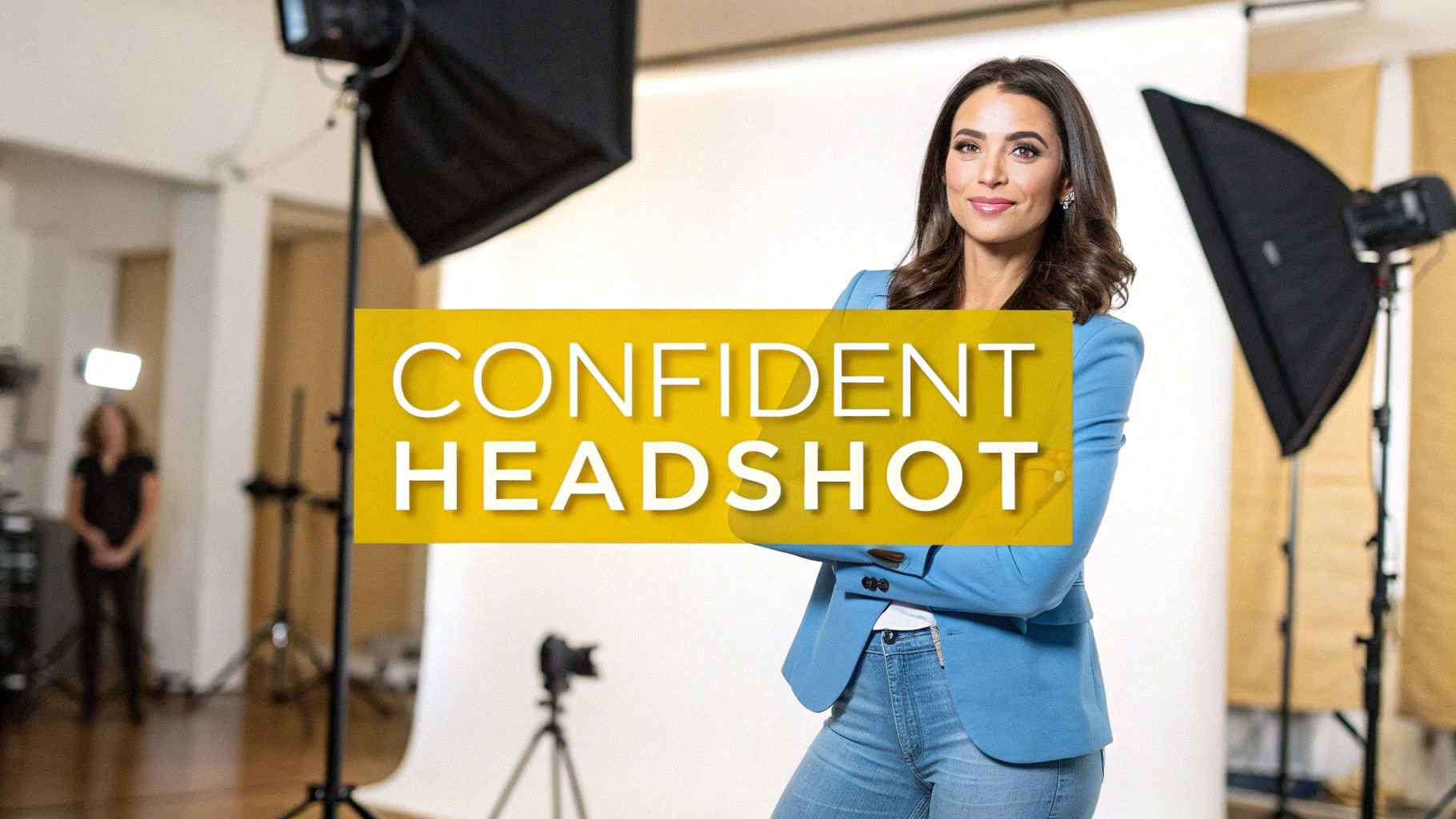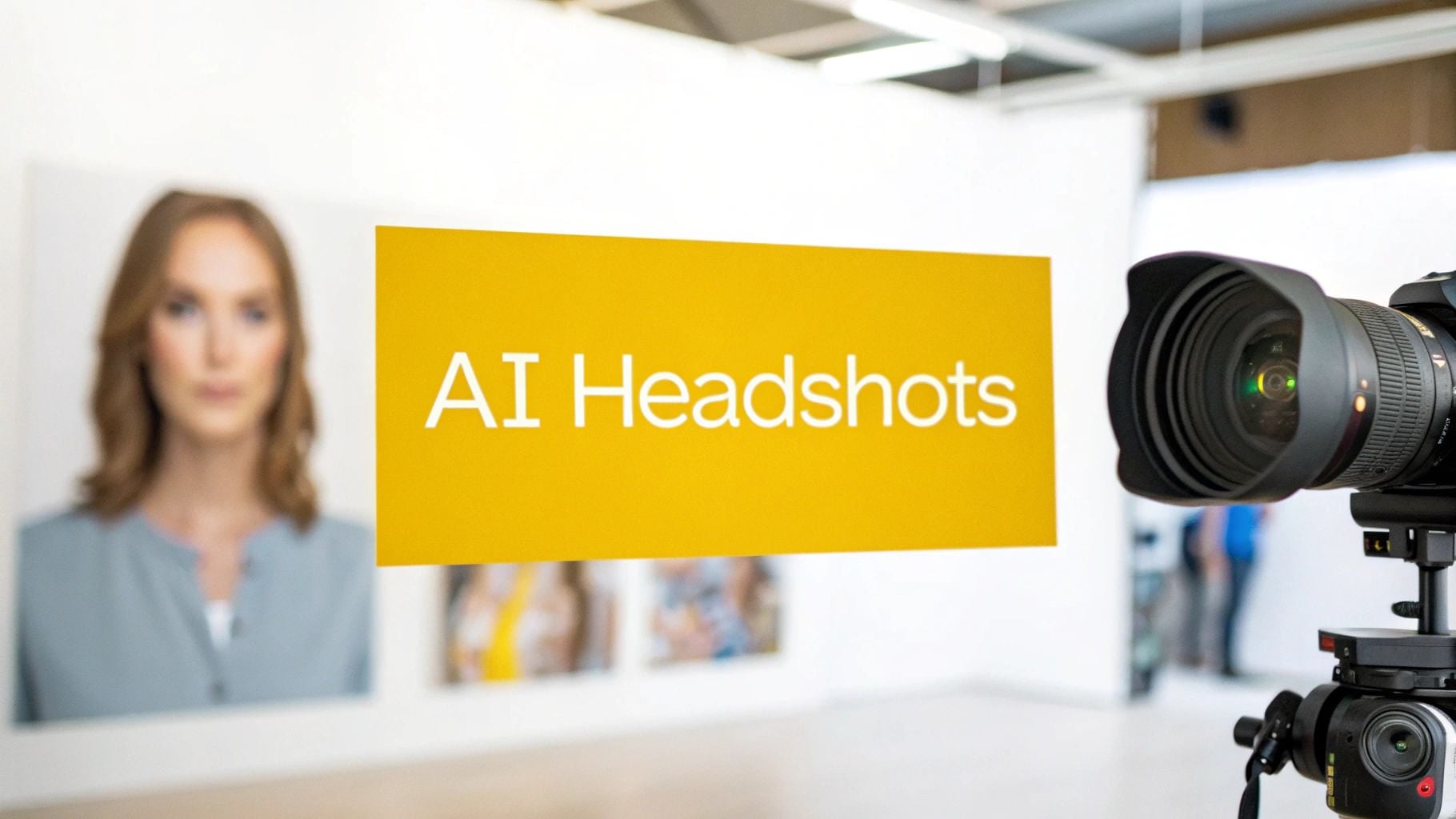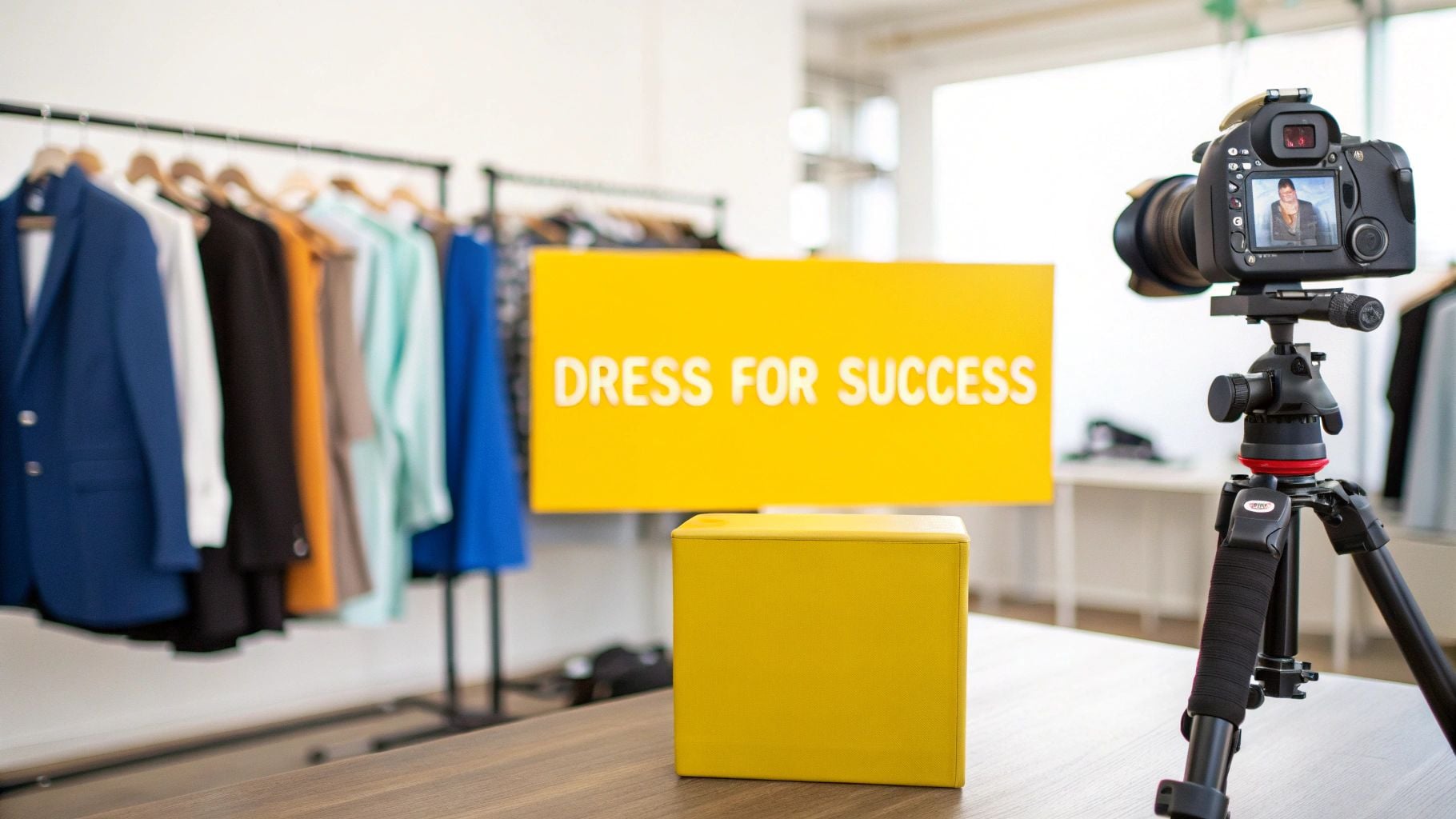Your headshot is often your digital handshake. It’s the first impression you make on recruiters, clients, and colleagues. Before they read a single word of your profile, they have already formed an opinion based on your photo. This is where understanding how to project confidence is essential.
When you upload your own photos to an AI headshot generator, remember that the algorithm learns from your non-verbal cues. Your posture, eye contact, and expression are the raw materials it uses. The AI refines these signals to create a final image that broadcasts competence and trustworthiness.
The Psychology Behind a Confident Headshot
Think about what makes someone seem confident in person. It is rarely one single thing, but a combination of subtle signals. A real smile that crinkles the eyes suggests warmth and makes you seem approachable. Looking directly at someone conveys honesty and self-assurance. An open posture, with your shoulders back and chest open, communicates that you're receptive and secure.
These are not just empty gestures; they are powerful psychological triggers that build instant rapport.
AI headshot tools are designed to pick up on these micro-expressions and enhance them to create what’s known as the 'trust effect.' We are naturally more inclined to trust someone who appears friendly and confident.
AI can also tap into the 'halo effect'—a cognitive bias where a polished, professional appearance leads people to assume you are competent and reliable in other aspects of your work.
The most effective headshots don't just show what you look like; they tell a story about who you are. Confidence is communicated through authenticity, not perfection. Aim for an image that feels like the best, most self-assured version of yourself.
By carefully selecting your input photos and picking AI-generated results that capture these cues, you are not faking confidence. You are simply using a Headshots AI like Headyshot to highlight the capable, confident professional you already are. This ensures your first digital impression is as strong as a firm, in-person handshake.
Preparing Input Photos to Project Confidence
The quality of your AI-generated headshot depends entirely on the photos you provide. If you upload blurry, poorly lit, or uninspired selfies, the AI will produce equally uninspired results. The key is to provide clear, strong images that already signal the confidence you want to project. You do not need a professional camera; your smartphone is sufficient.
What truly matters are your expression and posture. Take a few minutes to be intentional with your shots. The way you hold yourself and the look in your eyes will directly shape the final headshots.
Master Your Pose and Expression
A powerful stance begins with good posture. Standing or sitting up straight, rolling your shoulders back, and opening up your chest makes an immediate difference. This simple adjustment communicates self-assurance and approachability.
A common mistake is facing the camera straight-on, which can appear stiff or confrontational, like a passport photo. Instead, try angling your body slightly away from the camera and then turning your head back to face the lens. This creates a more dynamic and engaging look.
Your expression is just as crucial. For a focused gaze, try the "squinch." This technique involves subtly tightening your lower eyelids, as if focusing on something in the distance. It makes you look more thoughtful and composed. Pair this with a genuine smile—one that reaches your eyes. This is known as a "Duchenne smile," and it signals authentic warmth.
This visual demonstrates how to combine these elements for a pose that radiates confidence.

The image shows how small, deliberate adjustments in your stance can have a large impact on how you are perceived.
A significant mistake is providing the AI with only one type of photo. Upload a variety of expressions and angles. Mix smiling shots with more serious ones, and include a few from slightly different positions. This variety gives the AI more data to work with, leading to more nuanced and realistic headshots.
To help you prepare, here is a quick guide on common poses and what they communicate. Use this to think about the story you want your headshot to tell.
Posing Techniques to Project Confidence
| Posing Technique | What It Communicates | How to Do It |
|---|---|---|
| The Slight Lean | Approachability, engagement, dynamism | Lean your upper body slightly toward the camera from the waist. Keep your posture straight. |
| Shoulder Angle | Confidence, openness, a relaxed demeanor | Turn your body about 45 degrees away from the camera, then turn your head back to face the lens. |
| Chin Down (Slightly) | Authority, focus, thoughtfulness | Lower your chin just a fraction of an inch. Avoid tucking it in too far, which can create a double chin. |
| The 'Squinch' | Intensity, focus, confidence | Gently squint by raising your lower eyelids. Think of it as smiling with your eyes, but with focus. |
| Hands in Pockets | Casual confidence, relaxation | Place your thumbs or a few fingers in your pockets, keeping your arms relaxed at your sides. |
| Crossed Arms | Authority, expertise (when done right) | Cross your arms loosely over your chest, keeping your shoulders back and relaxed. Avoid a tight, defensive cross. |
Practicing these techniques is about learning to speak the non-verbal language of confidence so the AI can translate it perfectly.
Remember, the photos you upload are the foundation for learning how to look confident in AI headshots. Taking the time to capture quality input photos is the most important step to get a final portrait you will be proud to use.
Choosing Outfits That Signal Professionalism
What you wear in your photos sends an immediate message. The clothes you choose are a significant part of the data you provide to the AI, helping it build a headshot that communicates competence and confidence. Your goal is to guide the AI, and your wardrobe is one of your most powerful tools to do that.

Color choice has a psychological impact. Solid, classic colors typically work best because they do not distract from your face. Navy blue, for example, is known to convey trustworthiness, while black can project authority and sophistication. These are simple but effective cues.
The fit and style of your clothes are just as important. Ensure your outfits are well-fitted—not too baggy or too tight. For corporate or legal fields, a crisp blazer is a reliable choice. In tech or creative industries, a smart collared shirt or a high-quality knit top can strike a balance between professional and approachable.
Key Considerations For Your Attire
When selecting outfits for your input photos, stick with timeless, simple pieces. Avoid loud patterns, large logos, or overly trendy items, as they can date your headshot and draw attention away from you.
Here are a few guidelines to keep in mind:
- Solids Are Best: Stick to solid colors like blue, gray, black, or rich jewel tones. They look clean, professional, and keep the focus on your face.
- Simplicity is Key: Opt for classic necklines like a crew neck, boat neck, or a subtle V-neck. Unless your personal brand is very casual, avoid basic t-shirts or hoodies.
- Focus on the Top Half: Remember, these are headshots. The AI primarily considers what you are wearing from the waist up. Ensure your top is clean, pressed, and fits well across the shoulders and chest.
A common mistake is taking input photos against a busy background. A simple, plain wall is your best option. It gives the AI nothing else to focus on but you and your outfit, which leads to a cleaner and more professional result.
By putting thought into your wardrobe, you provide the AI generator with the best possible material. A service like Headyshot can then use this strong input to produce a variety of polished options. This preparation is key to knowing how to look confident in AI headshots and creating an image that opens doors.
Selecting and Refining Your AI Headshots
You have provided the AI with your best source photos. Now it is time to review the results. You will transition from director to curator, selecting the image that best represents you.
The AI will generate a range of options. Your job is to sift through them and find the one that not only looks like you but also feels like you. You are looking for the image that captures the authentic, confident professional you want to portray.
How to Select the Perfect Headshot
Finding the right image means striking a balance between a realistic likeness and a polished, professional look. You will need to inspect the details to ensure your final choice is both believable and impressive.
Here is what to look for when reviewing a batch of AI-generated portraits:
- The Eyes Have It: Are they clear, focused, and symmetrical? A good AI headshot will have a natural catchlight or "sparkle" in the eyes, not a glassy, fake-looking stare. This is often a key indicator of quality.
- Believable Skin Texture: Avoid any image that looks overly smoothed or airbrushed. A professional photo retains a hint of natural skin texture, which makes the image feel real and trustworthy.
- Solid Composition: Is the framing balanced? Your face should be the clear focal point. Watch out for strange crops, distracting backgrounds, or awkward head tilts that the AI can sometimes create.
Be discerning here. While AI tools are impressive, they are not perfect and can sometimes introduce small flaws. Some experts have noted that giveaways like unnatural skin tones or strange details can reduce an image's credibility, so it's wise to review each one carefully. You can read more on potential AI headshot imperfections to get a better sense of what to watch for.
Expert Tip: Do not just glance at the images. Zoom in. Look closely at the hands (if visible), the ears, and the hairline. These are common areas where AI can make mistakes, and spotting these issues is key to choosing a truly professional-grade photo.
While exploring AI-generated imagery, you might also find it interesting to see how this technology can be used for more casual purposes, like when you create cartoon avatars instantly with AI.
By carefully curating the most authentic result, you have successfully learned how to look confident in AI headshots. You have created a powerful new asset for your professional brand. A great AI headshot gives you a high-quality, convenient way to manage your first impression online. When you choose an image that is both flattering and genuine, you build an immediate connection with your audience.
You now have a fantastic photo ready for your LinkedIn profile, speaker bio, or company website. The best next step is to generate a few of your own.
Why a Great Headshot Is a Career Essential
In a world where we often meet online before we shake hands, your headshot is your first introduction. It is the face of your LinkedIn profile, your "About Me" page, and your speaker bio. Before anyone reads about your skills, they have formed an impression based on that picture.
This is why a strong headshot is a smart career move, not just a matter of vanity. A photo that projects confidence and approachability builds instant trust.

Using AI for this is no longer a futuristic concept; it is a current reality. A recent poll found that 44% of American professionals are open to using AI for their headshots, a number that jumps to 55% for Millennials. It is clear that AI is becoming a standard tool for crafting a polished personal brand.
A high-quality AI headshot gives you control over that critical first impression, ensuring it is both powerful and positive.
Frequently Asked Questions
Can an AI Headshot Really Look Authentic?
Yes. A high-quality AI-generated headshot can be indistinguishable from a professionally shot photograph. The key lies not just in the technology, but also in the quality of the input photos you provide.
The better your input photos—clear, well-lit, and showing a variety of your natural expressions—the better the final portrait. Modern AI is skilled at capturing the nuances of skin texture, hair, and unique facial features. When reviewing your results, check the details that make you unique. The best images will look like you on your best day, not like a plastic, airbrushed avatar.
What's the Single Most Important Thing for a Confident Headshot?
The most important element is the expression, specifically the eyes and mouth. A look of quiet confidence comes from making direct eye contact with the camera, paired with a slight, genuine smile. This combination signals that you are approachable, trustworthy, and self-assured.
A helpful technique is the "squinch." It is a subtle squint that tightens the lower eyelid slightly, making your gaze appear more focused and intentional. When paired with a relaxed, natural smile, this creates a universally powerful and confident look. Mastering this is key to learning how to look confident in AI headshots.
Remember, confidence is often quiet. You do not need a large, toothy grin. A calm, self-assured expression with focused eyes can often appear more powerful and competent to viewers. This subtle approach helps build trust and credibility.
How Many Photos Should I Upload for the Best AI Results?
Quality and variety are more important than sheer quantity, but a good range to aim for is 10 to 20 high-quality images. Do not just upload 20 selfies from the same angle. The AI needs a well-rounded set of data about your face.
To provide the best data, make sure you include:
- Shots from different angles (e.g., straight-on, three-quarter view)
- A range of expressions (e.g., smiling, neutral, thoughtful)
- Various lighting conditions (while avoiding deep, harsh shadows)
The more varied your input, the more accurately the AI can learn your unique features. This provides a richer, more diverse set of final headshots to choose from, increasing the likelihood that you will find the perfect, confident portrait.
Creating a compelling, professional headshot is now more accessible than ever. To see how AI headshots tool can generate studio-quality portraits for you in minutes, explore our AI Headshot solution. Just upload a few selfies, choose styles and get up to 200 photos in 15 minutes.





